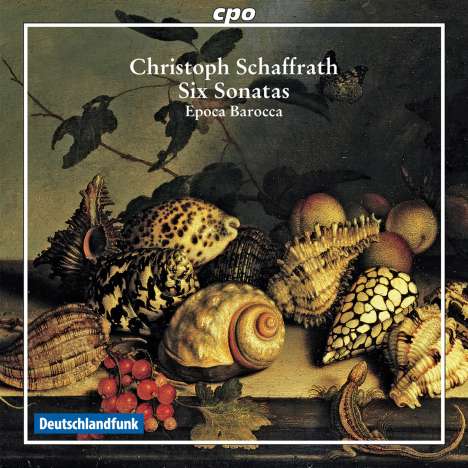Christoph Schaffrath: Kammermusik Vol.2
Kammermusik Vol.2
CD
CD (Compact Disc)
Herkömmliche CD, die mit allen CD-Playern und Computerlaufwerken, aber auch mit den meisten SACD- oder Multiplayern abspielbar ist.
Derzeit nicht erhältlich.
Lassen Sie sich über unseren eCourier benachrichtigen, falls das Produkt bestellt werden kann.
Lassen Sie sich über unseren eCourier benachrichtigen, falls das Produkt bestellt werden kann.
- Duett f-moll für Fagott & Cembalo; Duett d-moll für 2 Violen da gamba; Duett b-moll für Violine & Cembalo; Duett C-Dur für 2 Cembali; Duett B-Dur für Oboe & Cembalo; Duett g-moll für Fagott & Cembalo
- Künstler:
- Epoca Barocca
- Label:
- CPO, DDD, 2003-2007
- UPC/EAN:
- 0761203744022
- Erscheinungstermin:
- 15.11.2009
Ähnliche Artikel
Epoca Barocca & Schaffrath II
Der Sachse Schaffrath war Organist, Cembalist und Komponist zahlreicher wertvoller Instrumentalwerke und die Kammermusik, die eine unglaubliche satztechnische Vielfalt aufzeigt, wurde zum Kernpunkt seines Schaffens. Auf der vorliegende Schaffrath-CD vereint der Komponist verschiedene Kompositionen für nur zwei Instrumente und stellt das kontrapunktische Grundprinzip der Triosonate als eine Art ideelles Zentrum dar, denn der Oberbegriff »Duetti« bezieht sich hier auf Werke unterschiedlicher Faktur und Besetzung. Um ein Duo im engeren Sinne handelt es sich beim Duetto d-moll für zwei Gamben. Die übrigen Sonaten beziehen allesamt das Cembalo ins kammermusikalische Spiel mit ein, und zwar ausnahmslos als »obligates« Element. Damit wird die Oberstimme des Cembalos selbst Melodieträger.
Epoca Barocca & Christoph Schaffrath II
The Saxon Schaffrath was an organist, harpsichordist, and composer of numerous valuable instrumental works, and his chamber music displaying an incredible compositional-technical diversity became the genuine focus of his oeuvre. On the present second Schaffrath CD the composer juxtaposes various works for a mere two instruments and has the fundamental contrapuntal principle of the trio sonata function as a sort of ideal center: here the general heading »Duetti« refers to works of various textural and instrumental structures. The Duetto in D minor for two gambas is a duo in the stricter sense of the term. The other sonatas all include the harpsichord in the chamber-musical process, where it serves without exception as an »obbligato« (that is, concertizing) element. As a result, the upper voice of the harpsichord itself becomes a conveyer of melody and an equal partner in dialogue with the violin, oboe, or bassoon.
Der Sachse Schaffrath war Organist, Cembalist und Komponist zahlreicher wertvoller Instrumentalwerke und die Kammermusik, die eine unglaubliche satztechnische Vielfalt aufzeigt, wurde zum Kernpunkt seines Schaffens. Auf der vorliegende Schaffrath-CD vereint der Komponist verschiedene Kompositionen für nur zwei Instrumente und stellt das kontrapunktische Grundprinzip der Triosonate als eine Art ideelles Zentrum dar, denn der Oberbegriff »Duetti« bezieht sich hier auf Werke unterschiedlicher Faktur und Besetzung. Um ein Duo im engeren Sinne handelt es sich beim Duetto d-moll für zwei Gamben. Die übrigen Sonaten beziehen allesamt das Cembalo ins kammermusikalische Spiel mit ein, und zwar ausnahmslos als »obligates« Element. Damit wird die Oberstimme des Cembalos selbst Melodieträger.
Product Information
Epoca Barocca & Christoph Schaffrath II
The Saxon Schaffrath was an organist, harpsichordist, and composer of numerous valuable instrumental works, and his chamber music displaying an incredible compositional-technical diversity became the genuine focus of his oeuvre. On the present second Schaffrath CD the composer juxtaposes various works for a mere two instruments and has the fundamental contrapuntal principle of the trio sonata function as a sort of ideal center: here the general heading »Duetti« refers to works of various textural and instrumental structures. The Duetto in D minor for two gambas is a duo in the stricter sense of the term. The other sonatas all include the harpsichord in the chamber-musical process, where it serves without exception as an »obbligato« (that is, concertizing) element. As a result, the upper voice of the harpsichord itself becomes a conveyer of melody and an equal partner in dialogue with the violin, oboe, or bassoon.
Rezensionen
klassik.com 12/09: "Die Musiker von Epoca Barocca lassen Schaffraths kultivierte Kammermusik in vielen Facetten funkeln, indem sie die geistreichen kontrapunktischen Linien mit Bedacht nachzeichnen. Aus den komplexen Strukturen bilden sie sinnreiche Einheiten, die sie mit geschmackvollen Verzierungen versehen." klassik-heute.com 02/10: "Ein klingendes Kompliment an Schaffrath und eine Aufnahme, die rundum begeistert!"- Tracklisting
- Details
- Mitwirkende
Disk 1 von 1 (CD)
Duett für Fagott und Cembalo f-moll
-
1 1. Adagio
-
2 2. Allegro
-
3 3. Allegro
Duett für 2 Violen da gamba d-moll
-
4 1. Poco allegro
-
5 2. Adagio
-
6 3. Allegro
Duett für Violine und Cembalo b-moll
-
7 1. Poco andante
-
8 2. Allegro
-
9 3. Allegro
Duett für 2 Cembali C-Dur
-
10 1. Allegro non tanto
-
11 2. Poco adagio
-
12 3. Allegro
Duett für Oboe und Cembalo B-Dur
-
13 1. Largo
-
14 2. Allegrotto
-
15 3. Vivace
Duett für Fagott und Cembalo g-moll
-
16 1. Andante
-
17 2. Allegro assai
-
18 3. Allegro













